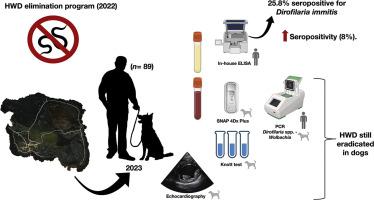Human exposure to Dirofilaria immitis following a canine heartworm disease elimination program in Linosa Island (Sicily, Italy)
IF 2.5
3区 医学
Q2 PARASITOLOGY
引用次数: 0
Abstract
The recent reports of Dirofilaria immitis causing canine heartworm disease (HWD) in highly endemic foci of Italy suggested the increasing risk for dogs and humans. In southernmost areas, such as Linosa island (Sicily), previous studies showed D. immitis infection in 58.9 % of dogs and a parasitic exposure in 7.9 % of islanders. These findings prompted a targeted elimination program, which led to HWD elimination by 2022. Hence, the present study aimed to assessantibody response and kinetics among Linosa residents one year after the implementation of canine HWD elimination program.
In 2023, blood samples were collected from 89 residents and 39 dogs. Participants completed a questionnaire with demographic and clinical data, including symptoms and relevant risk factors. Human sera were tested for D. immitis exposure using an in-house ELISA. Dog samples were analyzed using Knott test and a commercial ELISA rapid test (SNAP 4DX Plus, IDEXX). Additionally, previously infected dogs underwent echocardiographic evaluation. Genomic DNA was extracted from all human and dog samples and tested by PCR using Dirofilaria spp. and Wolbachia-specific protocols.
Serological analyses revealed that 25.8 % of the volunteers were seropositive for D. immitis, indicating an increase of seropositivity compared to 2020 (8 %). None of the human and dog samples tested positive for Dirofilaria spp. or Wolbachia by PCR.
Despite the successful elimination of D. immitis in dogs, the increased seroprevalence in humans indicates that the level of human exposure remains stable, even in the absence of canine infection. However, new seropositive cases may reflect exposures that had not yet seroconverted at the time of initial testing in 2020, or exposures that occurred outside the island. Long-term studies on antibody persistence and vector surveillance are essential to improve elimination efforts.

在利诺萨岛(意大利西西里岛)犬心丝虫病消除计划后,人类暴露于免疫Dirofilaria。
最近在意大利高度流行的疫源地报道了导致犬心丝虫病(HWD)的免疫丝虫病,这表明犬和人的风险正在增加。在最南端的地区,如Linosa岛(西西里岛),先前的研究表明,58.9%的狗感染了免疫弓形虫,7.9%的岛民感染了寄生虫。这些发现促使了一项有针对性的消除计划,到2022年消除了HWD。因此,本研究旨在评估Linosa居民在实施犬HWD消除计划一年后的抗体反应和动力学。2023年,从89名居民和39只狗身上采集了血液样本。参与者填写了一份人口统计和临床数据调查表,包括症状和相关风险因素。使用内部ELISA检测人类血清是否暴露于免疫弓形虫。采用Knott试验和商用ELISA快速检测(SNAP 4DX Plus, IDEXX)对犬标本进行分析。此外,先前感染的狗接受了超声心动图评估。从所有人和狗样本中提取基因组DNA,并采用双丝虫和沃尔巴克氏体特异性方案进行PCR检测。血清学分析显示,25.8%的志愿者免疫弓形虫血清阳性,与2020年(8%)相比,血清阳性增加。人类和狗的样本均未经PCR检测出Dirofilaria spv或Wolbachia阳性。尽管成功地消除了狗的免疫弓形虫炎,但人类血清阳性率的增加表明,即使在没有犬类感染的情况下,人类暴露水平仍保持稳定。然而,新的血清阳性病例可能反映了在2020年初步检测时尚未血清转化的接触,或发生在岛外的接触。长期研究抗体持久性和媒介监测对改善消除工作至关重要。
本文章由计算机程序翻译,如有差异,请以英文原文为准。
求助全文
约1分钟内获得全文
求助全文
来源期刊

Acta tropica
医学-寄生虫学
CiteScore
5.40
自引率
11.10%
发文量
383
审稿时长
37 days
期刊介绍:
Acta Tropica, is an international journal on infectious diseases that covers public health sciences and biomedical research with particular emphasis on topics relevant to human and animal health in the tropics and the subtropics.
 求助内容:
求助内容: 应助结果提醒方式:
应助结果提醒方式:


